Shooting (from the hip)
Written by John MacphersonThe responses to the recent NYC shooting made me stop and think (link and link to news reports).
I saw this exchange between duckrabbit and a few folks.
The discussion was presumably over the following image (although it may have been one of the two others here, my knowledge of Instagram filters is non-existent.):
Not being acquainted with Instagram I didn’t notice there was anything ‘odd’ about any of the images in question, nor that there was a possibility that one had perhaps been enhanced with an ‘aurora’ filter. I just saw pictures of a happening event in quite nice light, as recorded by bystanders, the ‘citizen journalists’ that mobile digital technology has transformed us all into. So here was a debate about the ‘appropriateness’ of instagram/filters on such an image. And asking the question: did the filter make the image too beautiful? Perhaps, but only if you knew it was a filter. What if the natural light was in reality quite stunning, a glorious dawn spilling across the scene? Was that somehow “too nice”?
I then read the responses to mr_mookie’s instagram image of the shooting scene with an injured person lying in the street, and the polarized opinions being expressed over this picture and his caption. Several comments were directed specifically at mr_mookie’s caption:
“They shoot, aw made you look! No really tho. Dude got popped!”
Seems mr_mookie’s ‘error’ was to not only use a familiar (to him) cultural reference, but also to post his observation and image on Instagram. He’d reached for a chunk of language that made perfect sense to him in so far as this event was concerned, the lyrics from a song he knew well and felt was not only significant but appropriate to the moment, a shooting in a city.
The NAS song in question ‘Made you look’ , contains the following lyrics:
hey shootin’! — Aw made you look
You a slave to a page in my rhyme book
Gettin’ Big/”big” money, playboy your time’s up
Where them gangstas? Where them dimes at?
There’s enough being written elsewhere about the ‘controversy’ generated over the use of the images, the ‘insensitive’ caption, did mr_mookie take cash for his work or not, and so on. You can google it to your hearts content.
I was more interested in the use of filters.
Because I think it’s all about filters. The ‘filter’ that a ‘photographer’ reached for to enhance the aesthetic of their image made their Instagram look too ‘glorious’ and raised the hackles of a few viewers. But if the lighting is naturally glorious must the photographer reach for the ‘drab day murder’ filter to tone down the glory to make it more visually ‘acceptable’?
The ‘filter’ of hip-hop experience that mr_mookie reached for in the form of NAS lyrics to embellish his caption, raised the hackles of others and a lot of bandwidth got used up giving him a hard time for his apparent callousness. But if the author had used, lets say a quote from Shakespeare, such as:
“Let’s kill him boldly, but not wrathfully; Let’s carve him as a dish fit for the gods” (Julius Caesar Act 2, scene 1)
which is wholly appropriate given the backstory to the murder, would this be any more acceptable? Or would it have simply alienated a different group of people who did not understand the reference? Perhaps mr_mookie loves quoting Shakespeare but decided against it this time because he thought nobody would ‘get it’?
Brutus:
Let’s be sacrificers, but not butchers, Caius.
. . . And, gentle friends,
Let’s kill him boldly, but not wrathfully;
Let’s carve him as a dish fit for the gods,
Not hew him as a carcass fit for hounds;
And let our hearts, as subtle masters do,
Stir up their servants to an act of rage,
And after seem to chide ’em.
In this age where ‘we are all journalists now’ with our smartphones and 24/7 networking, we are all connected.
Thats exciting. I can be part of it. I can participate in it, actively or passively. Revel in the on-the-spot-passerby narrative, watch it unfolding in real time, delivered to me wherever I am, on a bus, on the train, at home, bringing an immediacy to events in a way we’ve never experienced before.
However the major disconnect in all of this, and for me potentially quite troubling in its divisiveness, is the cultural distance between us.
We see things unfold through other’s filters, through the filter of their life experience and world view, their varying cultural references, and that ‘view’ gives a certain flavour to their observations. A flavour that others may fail to understand, or at worst utterly detest. And with these distractions we potentially lose sight of the message: two men died, tragically and unnecessarily.
And thats a ‘filter’ problem no smart phone manufacturer will ever ‘fix’ with a firmware upgrade.

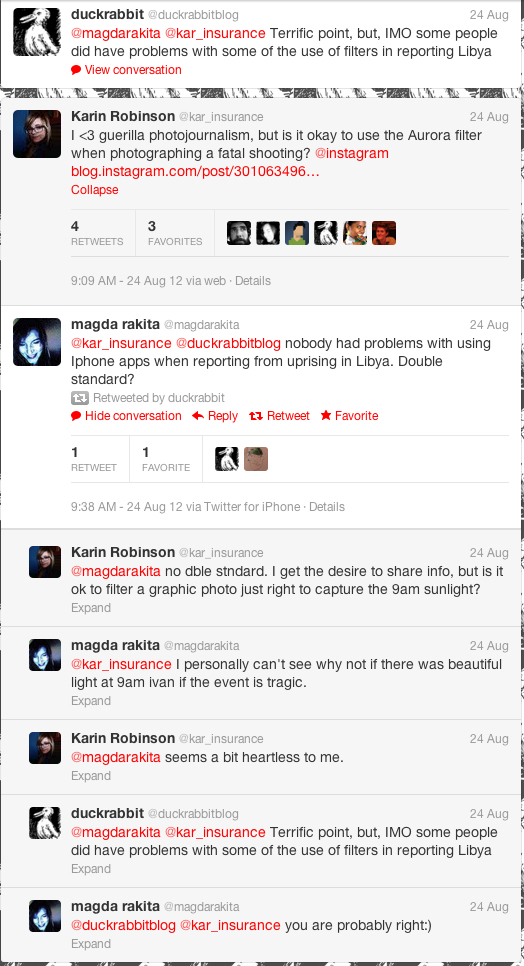
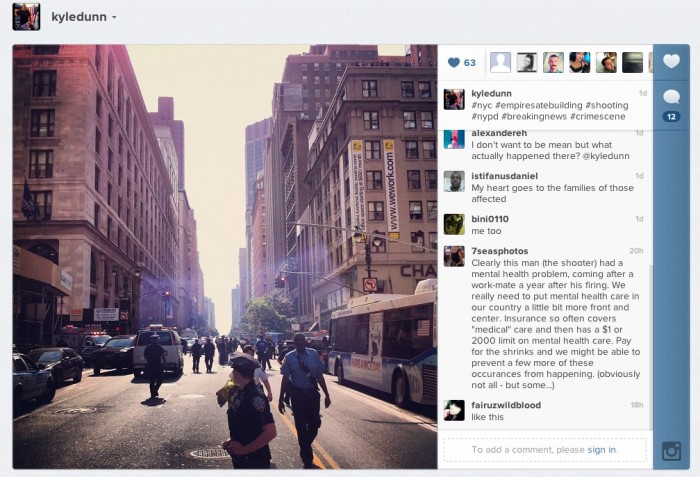
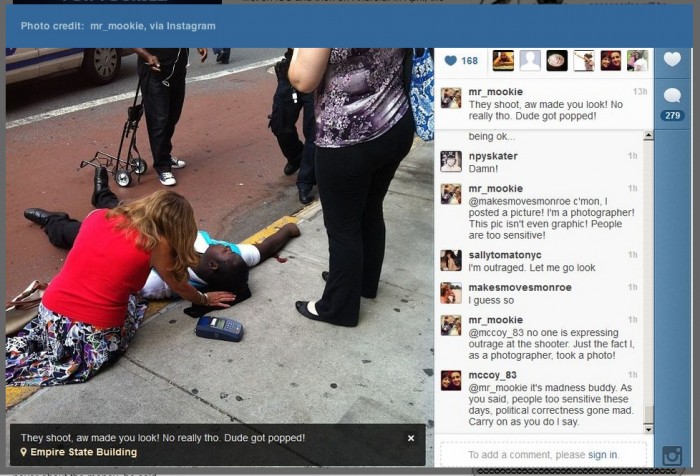
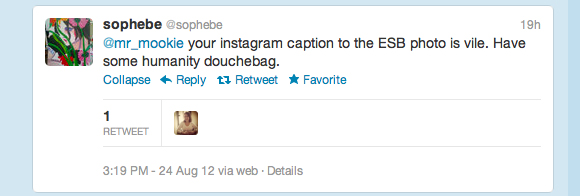
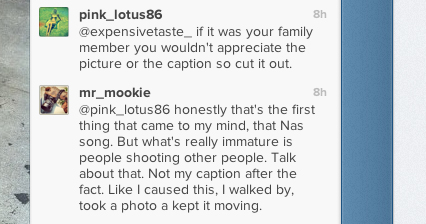
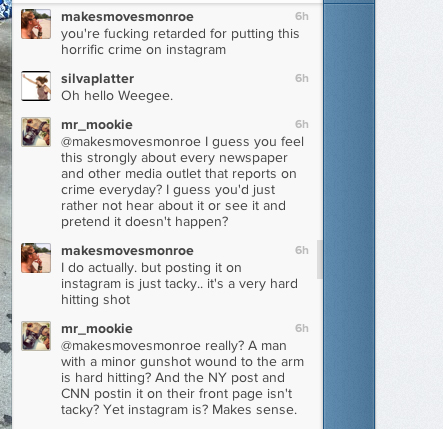
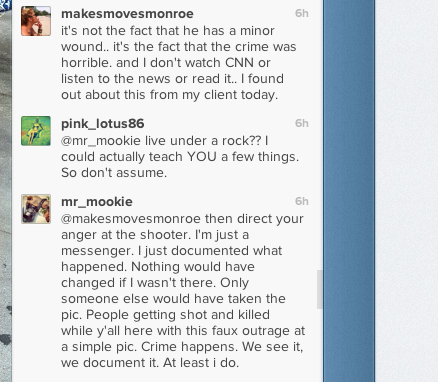
Discussion (5 Comments)
What’s the big deal? Filters? Show me a photojournalist that hasn’t used a polarizing filter or a neutral density filter! These just add a bit more (or less, or different) color – albeit digitally. It’s not like the dead guy actually cares, anyway.
Thanks for commenting Hasi.
What’s the big deal?
I think you might have missed the point. The ‘color’ that’s being added, and which I’ve considered, is the ‘color’ imparted by the individual viewer’s perception. You know, as in ‘he wore rose-tinted spectacles’ (thus ‘seeing’ everything as being warm and cosy.)
It’s all about perception. Cultural filters. Prejudice. Education (or lack of). World views. Specific references. That sort of ‘stuff’ – the ‘wrapping paper’ that you need to peel back to get to whatever lies at the heart of the matter.
“It’s not like the dead guy actually cares, anyway.” No. But a lot of people do care about how people are represented, in life, but particularly in death.
Only now I realised I ended up on tho fine blog!
So just to clear/add few things – initially I thought the comment was about using a phone and an app. This rises a question if that sort of tool shows enough respect? It seemed good enough to report major revolution so I can’t see why it shouldn’t be used closer to our homes. (Thank you though for pointing out there was some critisism over that).
However after the short tweet exchange with Karin I realised it was about a the beautiful light that day. This really surprised me. IMHO there is nothing wrong to show this tragic event this way. In the end it did happen on beautiful day. This made me think about two different issues. Would there be objection against capturing beatiful light when photographibg refugees, starving or dying people in Asia or Africa? Is there a Double standard in how we report from far away exotic locations and from home countries? The second issue is the taboo of death itself in western culture, but that’s probably theme for different blog post altogether.
Hello Magda – thanks for commenting. I have no answers to all of this! It is a mess of contradictions, preferences, perceptions (some informed, others not) but all of them in some way directing our attention towards, or away from, major issues. I agree that phones/apps are only tools, but like all tools the work they do is down to the craftsman/woman using them. I felt in this NYC shooting case that there were two separate (although connected) aspects – the choice of (iPhone) filters which we can choose to use, or not, and the cultural filters which we are often not aware we are either using when we make an image, or using when we view an image. The danger in either case is that they offer distractions and that ultimately may not serve the needs of the subject being photographed/reported/recorded. The issue of whether ‘nice’ light is appropriate for ‘unpleasant’ news is non-starter for me – stuff happens anywhere, at any time and accurate recording should reflect that.
Thanks Magda … ‘ The second issue is the taboo of death itself in western culture, but that’s probably theme for different blog post altogether.’
You write it and I’ll publish.